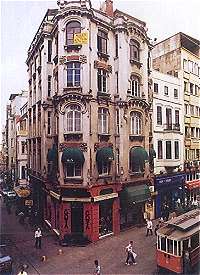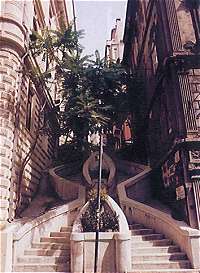Art Nouveau Architecture in Istanbul
 Under European influence Art Nouveau began to make an
impression on the architecture of the Ottoman capital of Istanbul in the
second half of the 19th century, and until the mid-1920s widely affected
the appearance of the city. Under European influence Art Nouveau began to make an
impression on the architecture of the Ottoman capital of Istanbul in the
second half of the 19th century, and until the mid-1920s widely affected
the appearance of the city.
It inspired the Turkish National Architecture
movement, and even today its traces persist as one of the defining
characteristics of those decades. Although Art Nouveau was at first
regarded by the intellectuals of the time as a pretentious affectation
imported from Europe, the movement had soon integrated with Turkey's own
architectural tradition.
Art Nouveau was first introduced to Istanbul by the
Italian architect Raimondo d'Aronco, and his designs reveal that he drew
freely on Byzantine and Ottoman decoration for his inspiration. D'Aronco
made creative use of the forms and motifs of Islamic architecture to
create modern buildings for the city. Art Nouveau architecture in Istanbul
is characterised not only by structural forms, but in the motifs of
stonework, woodwork, wrought iron and glass. To live in an Art Nouveau
style building at that time was an expression of social status and
modernism.
The districts of Galata and Pera (today Beyoglu),
with their large shops, tramway, smartly dressed inhabitants and European
way of life were where the new style of architecture first took root, and
today the loveliest examples of Istanbul Art Nouveau are still to be seen
on Istiklal Caddesi.
 After a terrible fire which destroyed much of the
area, Europeans began to construct apartment buildings with shops and
offices on the ground floors on the empty land. One of the lessons taught
by the fire was that in such densely built up areas, stone was a safer
building material. Examples of this stone architecture can still be seen
in Karakoy, and Eminonu;. For the traditional Turkish houses
separated by gardens, however, no such precaution was required, and wood
continued to be used for the most part. Art Nouveau was the perfect way to
fulfil the desire to individualise one's house; a concept that had long
since been embraced by the Ottomans. As a result the new art soon began to
make itself felt in the grandiose wooden houses built along the European
and Asian shores of the Bosphorus, in Uskudar, in Kadikoy, and on the
island of Buyukada. After a terrible fire which destroyed much of the
area, Europeans began to construct apartment buildings with shops and
offices on the ground floors on the empty land. One of the lessons taught
by the fire was that in such densely built up areas, stone was a safer
building material. Examples of this stone architecture can still be seen
in Karakoy, and Eminonu;. For the traditional Turkish houses
separated by gardens, however, no such precaution was required, and wood
continued to be used for the most part. Art Nouveau was the perfect way to
fulfil the desire to individualise one's house; a concept that had long
since been embraced by the Ottomans. As a result the new art soon began to
make itself felt in the grandiose wooden houses built along the European
and Asian shores of the Bosphorus, in Uskudar, in Kadikoy, and on the
island of Buyukada.
One of the principal ways in which Art Nouveau made
itself felt was in the façades. These featured bay windows,
balconies, loggias and other features jutting from the facade. Such
articulation was particularly striking when applied to corner buildings,
as we see in Flora Han, an office building in Sirkeci. In some cases, as
in the Frej Apartment Building, the protruding elements were placed to
either side of the facade, or with a defining element extending right
across it, as we see on the Botter House on Istiklal
Caddesi. At the same time these features have
distinctive decoration which makes them independent entities as well as
focal points in the façade as a whole. Wooden houses often had
a central bay window right above the entrance, rising for two or even
three storeys to culminate in a balcony or loggia.
Stone houses, on the other hand, usually had an
elaborately decorated cornice along the top storey, at which level the
absence of projections or withdrawal of the facade is immediately evident.
The bay window is not merely an element of the facade,
but a means of creating additional space. This use of
projection from the façade to create space is a traditional
feature of architecture in the Muslim countries.
Floriate motifs emphasising empty and full areas on
the façade were among the most distinctive characteristics of
Art Nouveau buildings, and in complete harmony with traditional Ottoman
art. The most common motif of this kind is the rose, which is to be seen
on the facades of many buildings in Pera and Galata. Roses as both buds
and in full bloom are to be seen on Flora Han, for instance, or as
entwined scrolling branches with thorns at the entrance of the Botter
House. Art Nouveau transforms wood into delicate and fragile lace, and
such decoration can generally be seen in the form of friezes on the houses
of this period along the Bosphorus and on Buyukada. The most beautiful
examples of such carved decoration are at Hidiv Kasri, the exquisite
country house built for the khedive of Egypt on a hilltop overlooking the
Asian shore of the Bosphorus.
Doors, bannisters, entrance gates and balconies are
adorned with wrought iron. The loveliest examples of Art Nouveau stained
glass are those of the Botter House and the Marquise Tea Room. Many Art
Nouveau buildings still grace Istanbul today with their sensitive and
graceful forms. Discovering this aspect of the urban landscape is a
delight for visitors to the city.
Source: Skylife 06/2001
Claudine Stefann, architect
Photos Ibrahim Öğretmen
|